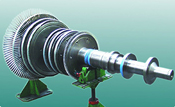OUR LOCATIONS
We can provide our services to power plants worldwide
Bradenton, Florida
941 - 527 - 6196
941 - 755 - 5229 (FAX)
Milwaukee, Wisconsin
414 - 698 - 5644
|

2N+1 Balancing Method
(Quasi-High Speed Balancing Method)
Our two recently published writings (from IFToMM 2014) linked below provide much more detail on the background and procedure of our 2N+1 balancing method, and an in-depth, conceptual description of the behavior of eccentric rotors as they pass through a critical speed, as a means of explaining why the 2N+1 balancing method is effective for rotors with distributed mass eccentricity. Continuing below is a shorter overview of the concept of the Quasi-high Speed Balancing Method.
Development of a New Balancing Approach for Significantly Eccentric or Bowed Rotors
Behavior of Eccentric Rotors Through the Critical Speed Range
Before any discussion of rotor balancing, it is important to first note that a “well-balanced” rotor is defined by producing no cyclic reaction forces in the bearings. This isn’t necessarily correlated to minimal measured displacement amplitudes (although it often can be).
Due to technological advancements in measurement sensors, and the need for better visualization and understanding of the physical motions of rotors in operation, the emphasis in diagnosing and resolving “vibrations” has shifted almost exclusively to measuring and assessing displacements. The primary goal of balancing to vanish the reaction forces in the bearings has been mostly forgotten in the balancing industry.
Most rotors in service for some time have a mixture of distributed eccentricities, which cause rigid-mode responses and bearing forces rising proportionally to the square of speed, and localized unbalances, which cause bending deflection amplitude responses, amplified at speeds coincident to modal resonance frequencies.
At Z-R Consulting, we utilize a unique understanding of rotordynamics behavior where we distinguish between unbalance (local heavy spots) and eccentricity (bows, machining errors), based on inertia effects. We also distinguish between modal (bending) responses at the critical speeds, and rigid mode responses present throughout the speed range. Our goal in balancing is to first minimize cyclic bearing reaction forces arising from rigid mode responses, before solving higher modal bending responses, if present.
A bowed or eccentric rotor should not be “unbent” or distorted using balance weights, especially just for the purpose of “reducing amplitudes”. Furthermore, an eccentric rotor must be balanced around the geometric axis connecting its journal centers, and not about the mean mass axis created by any mass eccentricities.
This is done with the proper axial distribution of balancing weights (using 2N+1 planes, where “N” is the highest operating mode of the rotor), so as to “mirror” the eccentricity distribution, and shift the mass axis of the rotor to be coincident to the rotor’s geometric axis (which is the straight line connecting the centers of the rotor journals). With this process, a bowed or distorted rotor maintains its intrinsic bowed shape, but spins balanced around its geometric axis at all speeds, producing no cyclic reaction forces or bending distortion.
The key is recognizing that in eccentric or bowed rotors, the rotor’s principal rotational axis switches from the geometric axis to the mean mass axis while passing through the peak of first system critical speed. This change in rotation axis alters the rotor’s static position in each bearing, and its relative orientation in space (within allowable bearing clearances). All balancing performed on a rotor solo in a balancing facility above the rotor’s first system critical will effectively balance the rotor around its mass axis. This fact is generally unrecognized or ignored, and even so, the amplitudes and bearing forces might look good in the facility (acceptable by “industry standards”, typically 0.004” peak-peak at criticals, and 0.002” at other speeds, including overspeed).
However, when a rotor is inadvertently balanced around its mass axis and is reinstalled in the field with the coupling constraints of adjoining rotors, forcing the rotor to spin around the geometric axis at all speeds, both the new balancing weights as well as the original mass eccentricity will now act as unbalance at high speed. This installed, “balanced” eccentric rotor will likely experience high vibrations and bearing forces through the speed range (or also through the load range for generator rotors), or it may be unable to run at all.
To assure the rotor is ultimately balanced around its geometric axis, the rigid mode responses from eccentricity must be resolved first at lower speeds, and balancing weights must be placed with the proper axial distribution as well as angular distribution, using a sufficient number of balancing planes (2N+1). The goal is to first shift the mass axis of the rotor to become coincident to the geometric axis, at lower speeds. This prevents the switch in rotation axis, and assures that balancing at any speed is performed around the geometric axis. Only after this condition is achieved, should the balancer proceed with modal balancing of responses at higher critical speeds, if observed. However, in many cases, focusing on and first resolving the rigid modes will simultaneously resolve most modal responses as well.
With the proper application of our 2N+1 balancing method, the inertia effects and axis change from eccentricities are negated, and the balanced rotor can be guaranteed to run smoothly upon reinstallation in the field.
|